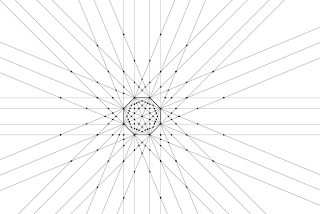Geometric drawings, ratios, number theory and geometry, geometric art, construction of regular polygons, tessellations and other visual mathematical concepts.
Monday, January 2, 2023
Monday, December 12, 2022
Friday, December 2, 2022
The 6n+3 series
What do the numbers 3,9,15,21,27,33,39,45,51,57,63,69,75,81,87,93,99... when it comes to regular polygons have in common?
Friday, October 21, 2022
Construction of a nonagon with compass and marked ruler
A visual construction of a regular nonagon with compass and marked ruler (neusis construction of a nonagon).
Start with a hexagon and triangle as a base,
Thursday, September 29, 2022
Tuesday, September 27, 2022
Tuesday, September 20, 2022
Mapping of regular polygons: octagon
 |
| √2+1 lines, one being the side of the regular octagon. |
 |
| √ 2 |
 |
| √ 2 |
 |
| a2 + b2 = c2. (√ 2+1)2 +(1)2 = c2 |
 |
| Lines of one |
 |
| a2 + b2 = c2. (√2/2)2 + (√2/2+1)2 =c2 |
 |
| Lines of 2 |
Sunday, September 18, 2022
Saturday, September 17, 2022
Friday, September 16, 2022
Thursday, September 15, 2022
Mapping of regular polygons
Mapping regular polygons(from my point of view) is mainly about measuring lines and segments of diagonal lines of regular polygons. It is also about looking for patterns occurring in regular polygons. In an octagon we can easily find ratios of square root 2, finding ratios and patterns in other polygons is much more difficult.
 |
| Lines of one in an octagon |
Wednesday, September 14, 2022
Monday, August 22, 2022
Monday, August 8, 2022
The nonagon and the square root 3
 |
| The nonagon and the square root 3 |
 |
| The nonagon and lines of 1 , 2 and square root 3. The circle in red has a radius of square root 3. |
Saturday, June 25, 2022
Saturday, June 11, 2022
Sunday, May 29, 2022
Friday, May 27, 2022
Monday, May 23, 2022
Wednesday, May 4, 2022
Saturday, April 2, 2022
The nonagon
THE REGULAR NONAGON
The regular nonagon or 9-gon has 9 lines of equal length arranged around a middle point.
Figure 1:The nonagon
Monday, September 6, 2021
Saturday, May 22, 2021
Regular polygons: nonagon
Visual geometry: the regular nonagon
 |
| Square root 3 in a nonagon |
 |
| Nonagon: lines of 1, 2 and square root 3 in a nonagon |































